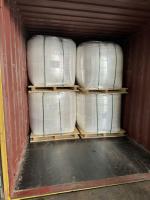cationic polyacrylamide of kemsep8403 kemsep8402 can be replaced by Chinafloc C series
kemsep8403 kemsep8402 are two cationic poyacrylamide with medium and high charge mainly used for water treatment and sludge dewatering.chinafloc C series can replace of them with good result.
Cationic polyacrylamide (CPAM) with medium and high charge densities is a versatile polymer used extensively in various industrial and environmental processes. Its main application lies in the treatment of water and wastewater, where it acts as a flocculant to remove suspended solids, organic pollutants, and other particulates. However, its utility spans beyond water treatment, touching upon areas such as paper production, oil recovery, and sludge dewatering. This detailed exploration delves into the mechanisms by which CPAM operates, its benefits across different applications, and the specific roles it plays in enhancing operational efficiency and environmental sustainability.
1. Introduction to Cationic Polyacrylamide
Cationic polyacrylamide is a type of polymer characterized by its long chains and positive charge, making it highly effective in attracting and binding negatively charged particles. The "medium" and "high" charge densities refer to the degree of cationic substitution along the polymer chain, which impacts its effectiveness in various applications. Medium-charge CPAM is typically used in situations requiring moderate flocculation strength, while high-charge CPAM is reserved for more demanding conditions, where stronger electrostatic interactions are necessary.
2. Water and Wastewater Treatment
The primary application of medium and high-charge CPAM is in the treatment of water and wastewater. It serves several crucial functions:
-
Flocculation: CPAM induces flocculation by neutralizing the negative charge of particulate matter in water, leading to the aggregation of particles into larger flocs. This process is essential for the efficient removal of suspended solids, organic materials, and other contaminants from water.
-
Sedimentation and Clarification: The formation of larger flocs facilitates their sedimentation, which is vital for the clarification of water. This step significantly improves water quality by reducing turbidity and removing harmful substances.
-
Sludge Dewatering: In wastewater treatment plants, CPAM is used to enhance the dewatering of sludge. By promoting the aggregation of sludge particles, it increases the efficiency of mechanical dewatering processes, resulting in a drier sludge that is easier and less costly to dispose of.
3. Paper Production
In the paper industry, CPAM is utilized as a retention and drainage aid. It improves the efficiency of the papermaking process and the quality of the final product:
-
Retention Aid: CPAM helps in retaining fines and fillers within the paper matrix, reducing raw material wastage and enhancing paper strength and smoothness.
-
Drainage Aid: By facilitating the rapid removal of water from the paper pulp during the sheet-forming process, CPAM improves the speed of the paper machine and the overall energy efficiency of production.
4. Oil and Gas Recovery
CPAM plays a pivotal role in enhanced oil recovery (EOR) techniques. It improves the efficiency of water flooding processes:
-
Water Flooding: CPAM is injected into oil reservoirs to increase the viscosity of the flooding water, improving its sweep efficiency and reducing the amount of residual oil in the reservoir. This process enhances oil recovery rates.
5. Soil Erosion Prevention and Agriculture
Medium and high-charge CPAM is applied in agricultural practices and soil management to prevent erosion and improve water quality:
-
Soil Stabilization: By increasing soil particle aggregation, CPAM reduces soil erosion caused by water and wind. This application is particularly beneficial in preserving arable land and preventing sediment runoff into water bodies.
-
Water Retention: CPAM can enhance the water-holding capacity of soil, improving crop yield in areas prone to drought.
6. Mining and Mineral Processing
In the mining industry, CPAM is used in the processing of mineral ores and the treatment of mining wastewater:

